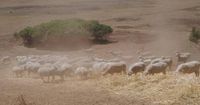Sheep producers in Victoria and South Australia are facing a challenging road to recovery as tough climate conditions continue to impact their operations. The recent forecasts by the Bureau of Meteorology predict average seasonal conditions for 2025 in these regions, yet producers fear that this may not be sufficient to mitigate the damage already done.
The underwhelming outlook comes at a crucial time when producers eagerly anticipate an autumn break to replenish their parched pastures. The industry is currently strategizing to cope with the long-term implications of the past two years, which have been especially tough on sheep enterprises.
Erin Lukey, a senior market information analyst at Meat & Livestock Australia, highlighted the urgency of the situation following consultations with producers. “Bureau of Meteorology three-month outlooks show average conditions going forward,” she explained, “but producers across those regions have said that average might not be enough to reverse that impact, get that groundwater in and improve that feed base.” She emphasized that the sentiment among farmers in Victoria and South Australia is not optimistic, as evident from low restocker prices.
Elke Hocking, a sheep and cattle producer from South Australia, detailed how a combination of factors has driven down the profitability of sheep farming. She anticipated a recovery period of two to five years, heavily dependent on seasonal conditions, interest rates, and commodity prices. “The feed base will be dependent on the level of ground cover producers have managed to maintain through strategies like containment feeding and, of course, getting adequate and timely rainfall in 2025,” Hocking explained. “Whether on dams or underground water, it is likely that above-average rainfall will be required to replenish depleted water reserves.”
Hocking and her husband operate multiple enterprises, including beef cattle and prime lambs, across various locations, including the Fleurieu Peninsula and Kangaroo Island. She noted that the dry conditions have severely impacted South Australian producers, especially those grappling with the consequences of higher interest rates and a sharp decline in livestock prices towards the end of the 2023 selling season.
According to Hocking, producers who proactively secured fodder earlier in the season had drastically better outcomes. “Those producers... managed to maintain good condition stock and excellent lambing and calving results, however this has come at a significant additional cost to the business, in the order of a doubling to tripling of feed costs,” she stated. “Some of this fodder came from substantial distances, and these producers received no subsidies or rebates on the freight component.”
The situation is exacerbated by water shortages, with Hocking indicating that many producers had improved their water systems in preparation for dry conditions but were still running low. She relayed early reports of suboptimal scanning percentages among ewes, potentially due to lower condition scores from the previous season’s lambing, affecting conception rates.
Meanwhile, a significant number of breeding stock were offloaded early this year to capitalize on better mutton prices, and many ewe lambs were reported sold to feedlots and slaughter. “This is also being driven by the already high cost of production within the prime lamb industry, which in 2023/2024 was sitting above $6/kg carcase weight for average producers,” Hocking noted, adding that expenses are projected to rise further in the upcoming 2024/2025 season.
Reflecting on their experience, Hocking shared that they resorted to purchasing local barley and hay, later procuring corn from New South Wales to support their operations throughout lambing. “Our lamb survival and marking rates were comparable to previous seasons,” she asserted, “and ewes came out of lambing in reasonable condition, being 0.5 condition score better than normal at joining in 2025. This was an excellent result but came at a significant financial cost.”
She elaborated on the importance of maintaining a financial strategy to ensure continued stability, indicating that they are currently doing monthly fodder and cash flow budgets to plan ahead. “Whilst it’s been mentally and financially challenging, we surround ourselves with positive forward-thinking solutions-focused producers who are all facing similar challenges, and this support network has been critical to maintaining a positive outlook for the future,” Hocking reflected.
Kevin Donnan, a livestock agent based in Ararat, stated that conditions in Western Victoria, while not the worst hit, have also been difficult. He noted large purchases of fodder and grain among local producers, as surface water remains a significant concern. “Surface water is a real issue and it’s probably one of our biggest concerns and that will be a concern post-break, going into next summer,” Donnan remarked.
While some decline in breeding numbers was expected, Donnan believed that the region wouldn’t experience a dramatic drop in livestock. “Numbers are reasonably stable, there may be a small drop-off,” he mentioned, “but I wouldn’t suggest we would be down dramatically in our area just yet.”
Despite the challenges, he observed a slight rebound in confidence among producers and noted that optimism remains. “Our breaks are traditionally late April, early May,” he said hopefully. “If we got a break in the next two to three weeks with a nice, warm soil temperature and the country is certainly bare, it’s open and ready; a good break will get grass growing and it’s surprising how quickly it will bounce back.”
Overall, sheep producers in Victoria and South Australia are currently in a precarious situation, with several factors contributing to the ongoing challenges. While the prospects of more average seasonal conditions offer a glimmer of hope, the path to recovery will take time and resourcefulness.



